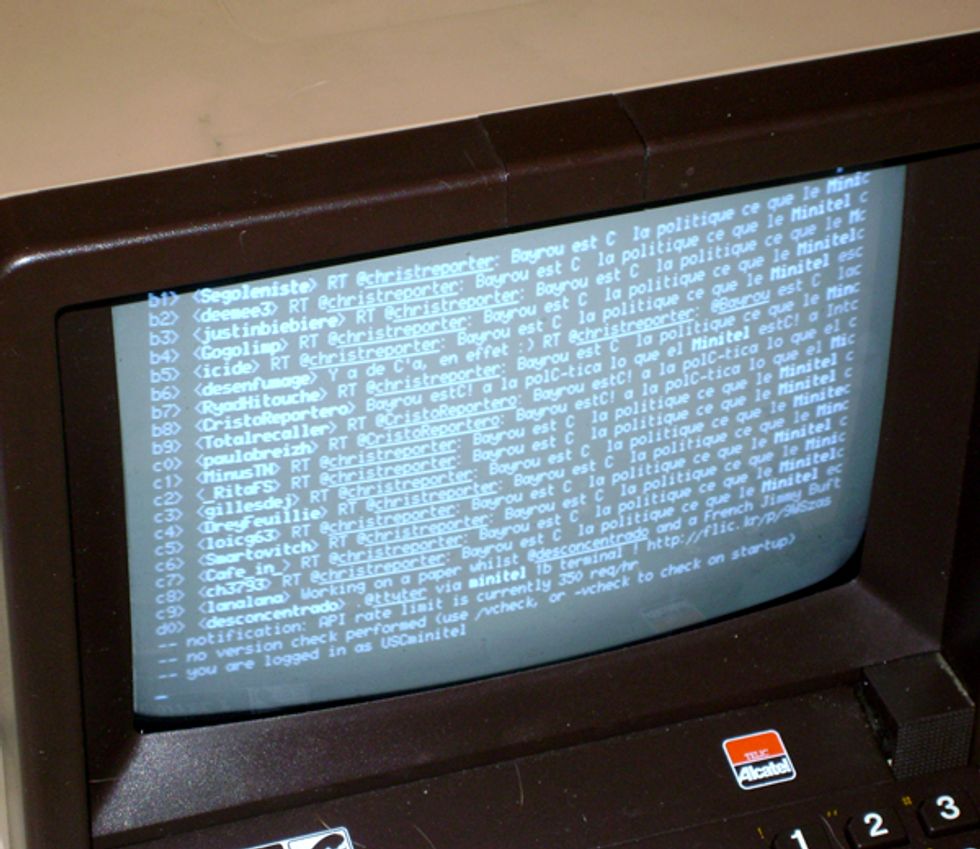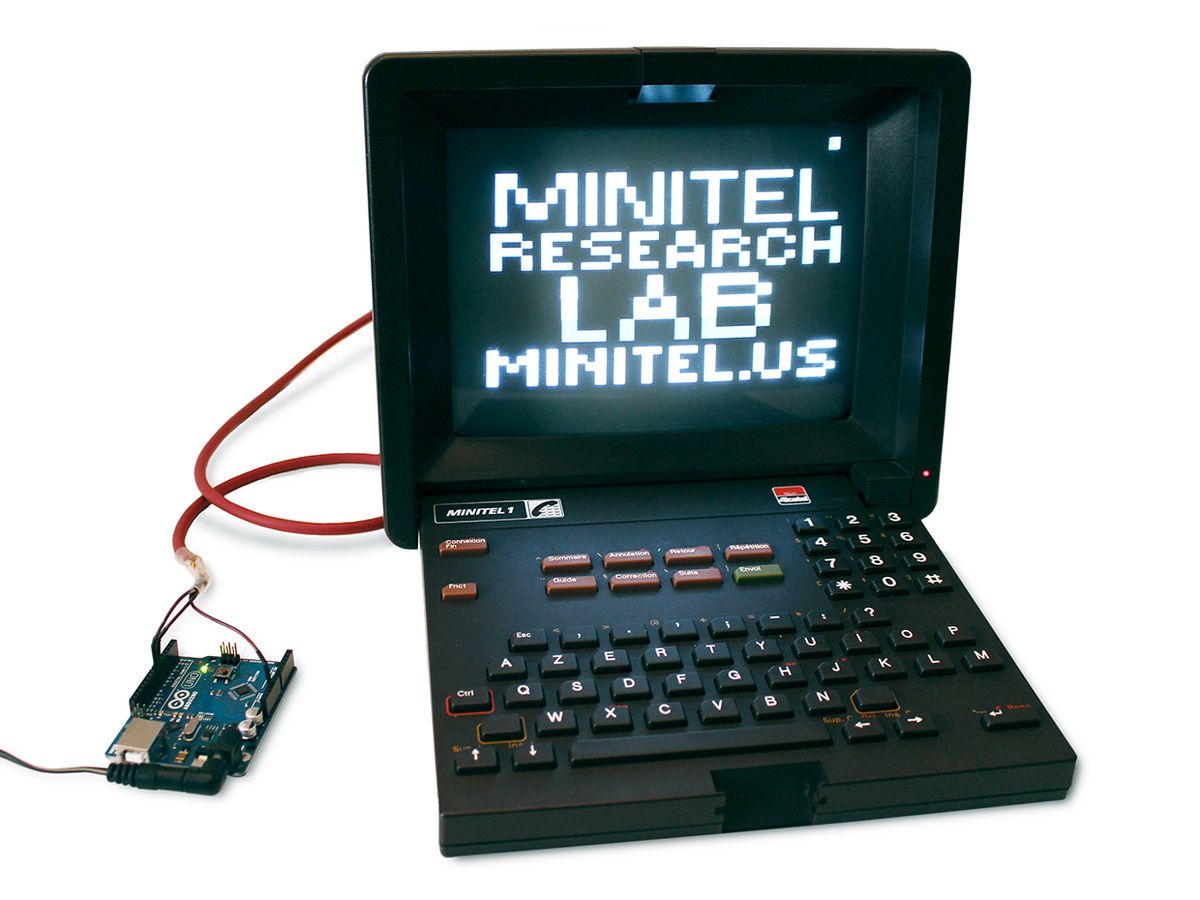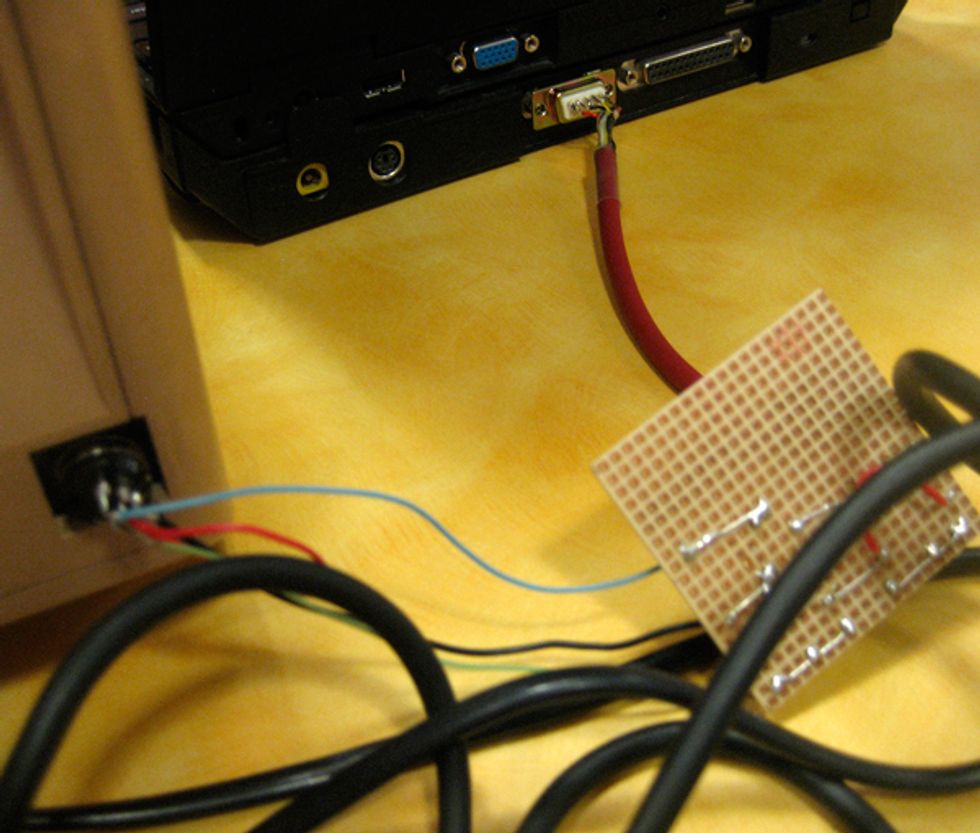One of us (Mailland) grew up in Paris in the 1980s, surrounded by advertisements for racy “pink” chat rooms, accessible through terminals connected to France’s Minitel network. They were a lucrative part of the wider Minitel economy, which also let you send messages, check bank balances, and read news. By 2000, as the Internet displaced the Minitel network, the billboards started being replaced by piles of terminals abandoned by trash cans. In 2010, while researching Minitel law and policy for a project that became the first English-language academic book on Minitel, I’d collected over 15 terminals of various models, when I met an American home brewer (Driscoll) who wanted to play with them.
We quickly completed our first project: turning a terminal into a Twitter client. Then we turned it into a webcam client; then, into a videotex slideshow display. We found a lot of help along the way because we weren’t the only people unwilling to let these stylish terminals end up as e-waste. Indeed, there’s now a vibrant Minitel hacking scene. You don’t need to be in France to try any of these upcyling projects either. Minitel was an open platform, and a number of failed attempts to replicate Minitel’s success means there are localized terminals to be found, with ones for Ireland, South Africa, and the United States, among others.
However, a lot of the guidance we relied upon is in French, so here we’d like to offer an English-language introduction to Minitel hacking.
The first thing you’ll need is a terminal. French terminals are plentiful on eBay, and despite their age, very sturdy. A reasonable offer shouldn’t top US $23 (shipping is the issue, thanks to relatively heavy cathode ray tubes. Expect that to cost at least $90 to North America). We recommend getting the “1B” model, the sturdiest and most versatile. Steer away from Magis, M2, or M12, each of which present problems for the home brewer. Your terminal must have a five-pin DIN connector in the back.
If you’re in North America, or anywhere else that uses 110-volt AC power, you’ll need a step-up transformer to feed your terminal with 220-V AC power (unless you’ve managed to obtain a native U.S. version, of course!). If all goes well, you’ll be able to turn it on, and be able to type on the keyboard and see characters echoed to the screen.
Our next step was to connect the Minitel 1B to a laptop running Linux. With the help of Google Translate, Driscoll found instructions to build a simple circuit for connecting a Minitel’s DIN serial port to a standard RS-232 port, posted by Frédéric Leperchois and Furrtek. This particular circuit—which shifts signal voltage levels appropriately between the DIN and RS-232 ends—has a long history in French hacker culture, appearing in 1980s computer magazines and “download kits,” enabling PC owners to use their Minitels as modems. We’ve reproduced the schematic here with English labels.

We laid out the circuit and sent a stream of data to the Minitel from the laptop. (Computers with RS-232 ports are becoming harder to find, so you may have to use an RS-232–to–USB converter cable). On our Linux system, the Minitel was connected to the port mounted at /dev/ttyS0. We used the agetty utility to create a console interface set to 4,800 baud, 7 data bits, and 1 even parity bit. We set the port speed on the Minitel by hitting P and the FNCT button together, followed by 4.
Instead of nice alphanumeric characters, however, we got strange symbols on the screen. The problem was that Minitel was expecting not ASCII but videotex. (Older British and Irish readers will be familiar with videotex from its use by the Ceefax and Aertel television information systems and the BBC Micro.)
We had to switch the terminal into the ASCII-derived téléinformatique mode, a little-known feature of the Minitel 1B. After we pressed FNCT+T followed by A, the familiar Linux prompt appeared. Within a few days, we had put together a Linux system monitor, an ASCII art webcam, and a Twitter client.
We were hooked. Thanks to Frederic Cambus, maintainer of a large repository of resources, we got our hands on the official technical specifications [PDF], which spell out exactly how Minitel graphics were encoded and displayed. Driscoll’s rudimentary French began to include technical jargon such as des caractères semi-graphiques. Using the specs, we built a simple Arduino Uno–based videotex server. We connected the serial communication pins on the Arduino to the Minitel’s DIN port and used the SoftwareSerial library to write videotex. The Minitel serial port was designed to interconnect with peripherals using a logical-high threshold level of 2.5 V or more and a logical-low threshold of 0.4 V or less. The Minitel detected Arduino’s 5-V signals without a problem, but we needed a logic-level converter for the Arduino to reliably detect the Minitel’s 2.5-V signals. With the help of an old 16-bit teletext authoring tool, we created Minitel screens and animations. We’ve exhibited this system to provoke conversation about the role of openness in the design of digital networks.
In recent years, the Minitel revival scene has seen an influx of participants, ranging from old-timers to teenage geeks. Legendary pink site 3615 SM has now been ported to the Internet and was recently demoed during an exhibit in New York City. Christian Quest has ported other services, including Minitel’s electronic phone-book service, complete with up-to-date information extracted via France Telecom’s public API. Github lists dozens of repositories tagged “minitel” including those by Eric Sérandour. A French engineering school has even introduced Minitel as part of its curriculum, assigning students the task of “giving a second life to Minitel.” The Minitel community is not shy about sharing tips and code. We hope you join us and reanimate these terminals by unleashing your creativity.
This article appears in the March 2019 print issue as “From Trash to Treasure: Turn a Minitel terminal into a Linux terminal or videotex display.”
Kevin Driscoll is an assistant professor of media studies at the University of Virginia. He and Julien Mailland are the authors of Minitel: Welcome to the Internet (MIT Press, 2017), and they are the founders of the Minitel Research Lab, USA, the world’s largest digital museum on the Minitel.
Julien Mailland is an associate professor of telecommunications at Indiana University's Media School. He and Kevin Driscoll are the authors of Minitel: Welcome to the Internet (MIT Press, 2017), and they are the founders of the Minitel Research Lab, USA, the world’s largest digital museum on the Minitel.





